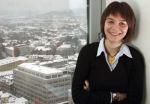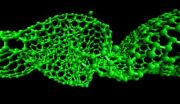Samples of vital human tumor tissue irradiated with ions for the first time
The goal is to further the development of ion beam cancer therapy
2010-12-18
(Press-News.org) Cancer treatment with ion beams developed at GSI is characterized by an excellent cure rate and only minor side effects. The therapy has been routinely in use for a little over one year. The effectiveness of the ion beams not only depends on the tumor type, but also on the genetic disposition and the personal circumstances of the individual patient. For the first time, scientists at GSI Helmholtzzentrum für Schwerionenforschung have irradiated samples of vital human tumor tissue in the scope of their systematical and fundamental research. Their long-term goal is to enhance the already highly effective ion beam therapy in a way that allows the optimization of the irradiation dose based on the specific tumor of the individual patient. Such a treatment would constitute a novel approach, as radiation treatment so far only considered the type and position of the tumor.
This research is only possible because the University of Frankfurt was able to produce samples of specific human tumors for the first time. The patient-derived tumor tissue is prepared in a way that keeps the tissue sample vital for several weeks. The fact that these samples are consistent with their natural environment allows the scientists to observe the effects of the radiation that occur in the treatment of patients. One of the points the researchers are examining is the so-called "bystander effect" — the effect that the irradiated cells have on their neighboring cells. Previous tests on artificial cell samples and animal experiments were very limited in this respect.
This cancer therapy developed at GSI has already proven highly effective, with very few side effects. "However, every tumor reacts differently to irradiation: some are more sensitive, stop growing or perish, others are more resistant and remain unaffected by the therapy. The effectiveness of the therapy varies from patient to patient", says Professor Marco Durante, head of the biophysics department at GSI Helmholtzzentrum. "The irradiation and subsequent analysis of a tissue sample taken from the patient allows us to find out about the tumor's characteristics. And based on this knowledge, the attending physician can optimize the tumor therapy for the individual patient."
Human tissue samples are typically obtained during surgery. A new method now makes it possible to keep those tissue samples vital in the laboratory over several weeks. "These so-called tissue slice cultures are used as a model system for biological studies, because they allow us to look beyond the events that occur in a single cell and help us study the tumor cells in their natural environment surrounded by other cells", explains professor Ingo Bechmann, who helped develop this new system at Charité in Berlin and Frankfurt University and who now holds a professorship at Leipzig University. Dr. Kosta Schopow, the Frankfurt-based physician and curator of the Senckenberg Foundation, had the idea of using tissue slice cultures for the research at GSI.
INFORMATION:
The first research results from the irradiation of tissue slice cultures at GSI have already been published:
- Modeling radiation effects at the tissue level / The European Physical Journal D (2010), DOI: 10.1140/epjd/e2010-00030-y, Müller et al
- Tissue slice cultures from humans or rodents: a new tool to evaluate biological effects of heavy ions / Radiation and Environmental Biophysics (2010), DOI: 10.1007/s00411-010-0293-1, Merz et al
ELSE PRESS RELEASES FROM THIS DATE:
2010-12-18
Plants that "lose the battle" during competitiveness for light because they are shaded by larger neighbours, counteract. They adapt by rapid shoot elongation and stretch their leaves towards the sun. The molecular basis of this so-called shade avoidance syndrome had been unclarified to date. Research scientists from the Utrecht University in the Netherlands and the Ruhr University in Bochum have now been able to unravel a regulation pathway. A specific transport protein (PIN3) enables the accumulation of the plant hormone auxin, which plays an important role during this ...
2010-12-18
"I have ready!" With this sentence the FC Bayern Munich coach Giovanni Trapattoni finished a furious rant about his team's performance in 1998. And "Mr Angelo" in a coffee advert points out to his neighbour with a mischievous smile: "I don't have a car at all". In both cases the Italians are unmistakeably recognizable and so the exuberant temperament of the first and the charming way of the second are seemingly "typically Italian".
The accent someone talks in plays a crucial role in the way we judge this person, psychologists of the Friedrich Schiller University Jena ...
2010-12-18
VIDEO:
Compression causes nanotubes to buckle and twist and eventually to lose atoms from their lattice-like structure.
Click here for more information.
PROVIDENCE, R.I. [Brown University] — A pipefitter knows how to make an exact cut on a metal rod. But it's far harder to imagine getting a precise cut on a carbon nanotube, with a diameter 1/50,000th the thickness of a human hair.
In a paper published this month in the British journal Proceedings of the Royal Society ...
2010-12-18
MANHATTAN, KAN. -- Two Kansas State University researchers focusing on rice genetics are providing a better understanding of how pathogens take over a plant's nutrients.
Their research provides insight into ways of reducing crop losses or developing new avenues for medicinal research.
Frank White, professor of plant pathology, and Ginny Antony, postdoctoral fellow in plant pathology, are co-authors, in partnership with researchers at three other institutions, of an article in a recent issue of the journal Nature. The article, "Sugar transporters for intercellular exchange ...
2010-12-18
Like a fence or barricade intended to stop unwanted intruders, the skin serves as a barrier protecting the body from the hundreds of allergens, irritants, pollutants and microbes people come in contact with every day. In patients with eczema, or atopic dermatitis, the most common inflammatory human skin disease, the skin barrier is leaky, allowing intruders – pollen, mold, pet dander, dust mites and others – to be sensed by the skin and subsequently wreak havoc on the immune system.
While the upper-most layer of the skin – the stratum corneum – has been pinned as the ...
2010-12-18
50 million years ago, mountains began popping up in southern British Columbia. Over the next 22 million years, a wave of mountain building swept (geologically speaking) down western North America as far south as Mexico and as far east as Nebraska, according to Stanford geochemists. Their findings help put to rest the idea that the mountains mostly developed from a vast, Tibet-like plateau that rose up across most of the western U.S. roughly simultaneously and then subsequently collapsed and eroded into what we see today.
The data providing the insight into the mountains ...
2010-12-18
Computer games and simulations are worthy of future investment and investigation as a way to improve science learning, says LEARNING SCIENCE: COMPUTER GAMES, SIMULATIONS, AND EDUCATION, a new report from the National Research Council. The study committee found promising evidence that simulations can advance conceptual understanding of science, as well as moderate evidence that they can motivate students for science learning. Research on the effectiveness of games designed for science learning is emerging, but remains inconclusive, the report says.###
The report is available ...
2010-12-18
Our flawed understanding of how decisions in the present restrict our options in the future means that we may underestimate the risk associated with investment decisions, according to new research by Dr Ole Peters from Imperial College London. The research, published today in the journal Quantitative Finance, suggests how policy makers might reshape financial risk controls to reduce market instability and the risk of market collapse.
Investors know that there are myriad possibilities for how a financial market might develop. Before making an investment, they try to capture ...
2010-12-18
Rapid turnover and remodelling of lipid membranes could help phytoplankton cope with nutrient scarcity in the open ocean.
A team led by Patrick Martin of the National Oceanography Centre has shown that a species of planktonic marine alga can rapidly change the chemical composition of its cell membranes in response to changes in nutrient supply. The findings indicate that the process may be important for nutrient cycling and the population dynamics of phytoplankton in the open ocean.
Tiny free-floating algae called phytoplankton exist in vast numbers in the upper ocean. ...
2010-12-18
Sociologists have long known that a college education improves the chances that an individual will volunteer as an adult. Less clear is whether everyone who goes to college gets the same boost in civic engagement from the experience.
In an innovative study that compared the volunteering rates of college graduates with those of non–college graduates with similar social backgrounds and high school achievement levels, UCLA sociologist Jennie Brand found something striking: A college education has a much greater impact on volunteering rates among individuals from underprivileged ...
LAST 30 PRESS RELEASES:
[Press-News.org] Samples of vital human tumor tissue irradiated with ions for the first time
The goal is to further the development of ion beam cancer therapy

